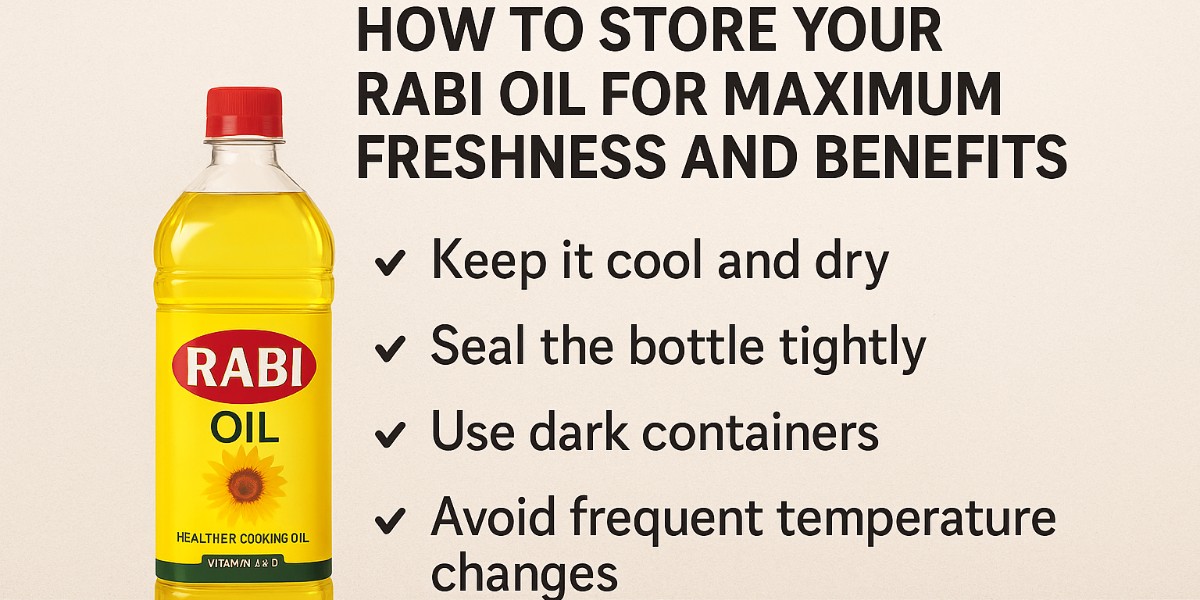
THE FOODIE’S
READ

Date: Oct 24, 2025
Cooking oil is a staple in every kitchen, but few people realize that how you store your oil can greatly impact its freshness, flavor, and nutritional value. At Rabi Foods, we ensure every bottle of Rabi Oil reaches you in its purest form—rich in essential fatty acids and antioxidants. However, maintaining that same quality at home depends on proper storage practices.
In this guide, we’ll explain the science behind oil preservation and share practical tips to help you keep your Rabi Oil fresh, healthy, and long-lasting.
Cooking oils like those from Rabi Foods—rich in monounsaturated (MUFA) and polyunsaturated (PUFA) fatty acids—are highly beneficial for heart and overall health. However, these healthy fats are also sensitive to light, heat, and air.
When exposed to these elements for too long, the oil can:
By following simple storage tips, you can extend the shelf life and preserve the integrity of your Rabi Oil—ensuring it stays as fresh as the day you opened it.
Before diving into the best storage methods, let’s look at the key factors that cause oil to deteriorate over time:
Ultraviolet rays from sunlight can break down the oil’s natural antioxidants, causing oxidation and flavor changes.
Warm environments—especially near stoves or ovens—can speed up the breakdown of unsaturated fats, leading to rancidity.
Every time you open the oil bottle, air enters and reacts with the oil’s molecules, starting the oxidation process.
Moisture can cause hydrolysis, leading to off-flavors and spoilage, especially if water or steam accidentally enters the bottle.
Store your Rabi Oil in a cool, dark place—such as a pantry or cabinet—away from direct sunlight and heat sources.
Always close the cap firmly after each use. This prevents oxygen from entering and moisture from forming inside the bottle.
Rabi Oils are packaged in high-quality, food-grade bottles that protect the oil from light and air.
If you ever transfer oil into another container, use:
Fluctuating temperatures can accelerate oxidation. If possible, store oil in a consistent environment—not too warm or cold.
If you buy Rabi Oil in bulk, divide it into smaller bottles for daily cooking and keep the rest sealed until needed. This minimizes air exposure and preserves freshness longer.
When cooking, avoid holding the oil bottle directly above steaming pots or pans. Steam can introduce moisture, shortening the oil’s shelf life.
Under proper storage conditions, Rabi Oils can remain fresh and flavorful for up to 12–18 months from the date of packaging.
Here’s a quick guide:
Always check the “Best Before” date printed on the bottle and use the oldest stock first.
Even with proper care, cooking oil can eventually spoil. Here are signs that your oil may no longer be good for use:
If your Rabi Oil shows any of these signs, it’s best to replace it to maintain both food quality and health benefits.
While refrigeration isn’t necessary for most Rabi Oils, it can help extend freshness in warmer climates.
Avoid freezing oil, as it can alter the flavor and composition.
At Rabi Foods, we believe that maintaining freshness also means being mindful of the environment. Once you’ve finished a bottle:
Proper storage not only preserves your oil—it supports Rabi’s vision for a cleaner, greener planet.
Keeping your Rabi Oil fresh and nutritious is simple when you understand what affects its quality. By storing it in a cool, dark, and dry place, tightly sealing the bottle, and minimizing exposure to light and air, you’ll ensure every meal benefits from the full richness and purity of Rabi Foods’ cooking oils.
Remember: the care you take after purchase is just as important as the care we take during production. Together, we can make sure every drop of Rabi Oil brings health, flavor, and freshness to your table—just the way it was meant to
Relevant Blogs

